A Buddha statue is a great way of cultivating tranquility and serenity within your garden. It can serve as a powerful symbol that radiates a profound sense of peace and harmony. There are many different buddha statues, by carefully selecting and placing a one, you can create a sacred space that invites introspection, mindfulness, and a deep connection with nature.
Each feature of the statue holds its own significance, encapsulating the teachings and wisdom of the Buddha. With its presence, your garden becomes a sanctuary, an oasis of calm where you can find solace and rejuvenation amidst the bustling world outside.
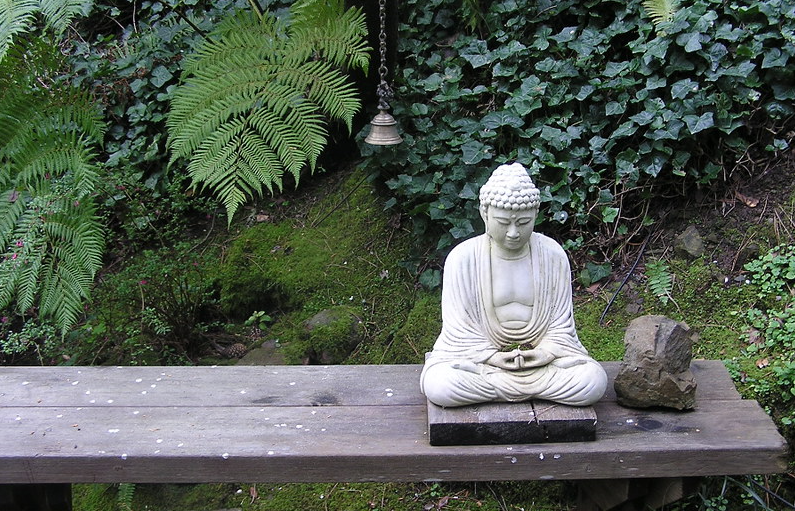
The Significance of Buddha Statues in Buddhist Culture
Buddha statues are symbols of the teachings of Gautama Buddha, the founder of Buddhism. Each statue represents a specific aspect of Buddha’s life or a particular quality such as compassion, wisdom, or enlightenment.
For instance, did you know that the position of Buddha’s hands, known as a ‘mudra’, signifies different teachings? A Buddha statue with hands resting in its lap symbolizes meditation, while one with a hand raised represents reassurance.
So, as we explore the world of Buddha statues, remember that each one carries a piece of history and a message from the teachings of Buddha. And by bringing one into your garden, you’re not just adding a beautiful element to your green space, but also a symbol of peace, wisdom, and enlightenment.
Understanding Different Types of Buddha Statues
Each type of Buddha statue carries a distinct symbolism, and understanding this can help you choose the one that resonates most with you and your garden. Below are the most common ones you will find in gardening stores…
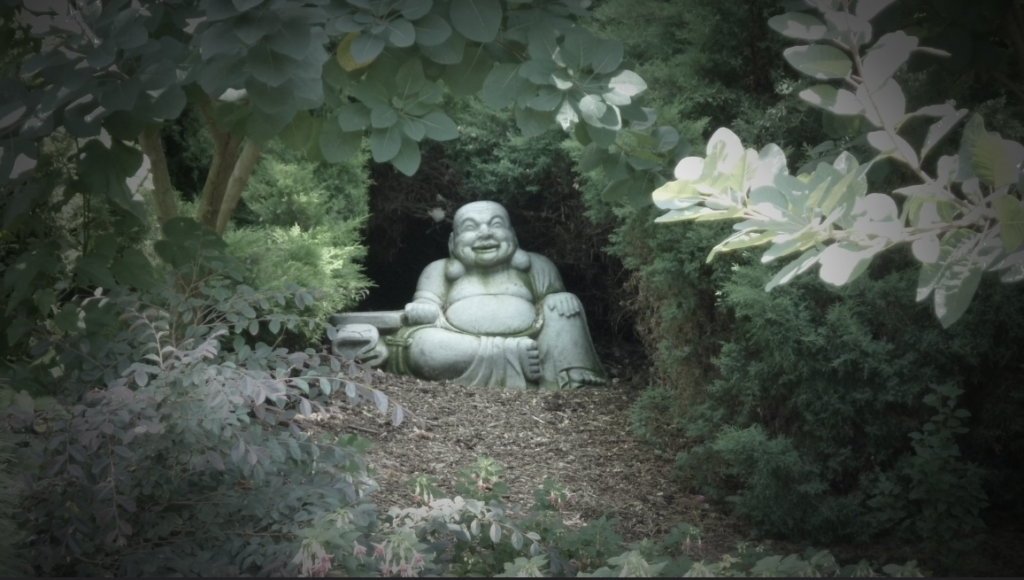
Laughing Buddha
Also known as the Buddha of Wealth, the Laughing Buddha is a popular choice for many gardens. This jolly figure is often depicted with a large belly, a wide smile, and carrying a sack of treasures. It’s believed to bring wealth, happiness, and prosperity. A Laughing Buddha statue in your garden can serve as a cheerful reminder to embrace joy and abundance in life. Place your Laughing Buddha statue in a prominent spot where it can be easily seen to attract positive energy and good fortune.
Reclining Buddha
The Reclining Buddha represents the historical Buddha during his last illness, about to enter the parinirvana. It’s a symbol of tranquility and serenity, making it a perfect addition to a peaceful garden sanctuary. A Reclining Buddha statue can be a great focal point in a quiet corner of your garden, creating a space for reflection and relaxation.
Meditating Buddha
The Meditating Buddha, often depicted in a seated position with hands resting on the lap, symbolizes enlightenment. This statue is a reminder of the path of mindfulness and inner peace, making it a wonderful addition to any garden. The Meditating Buddha statue is often used in Zen gardens, which are designed to promote tranquility and contemplation.
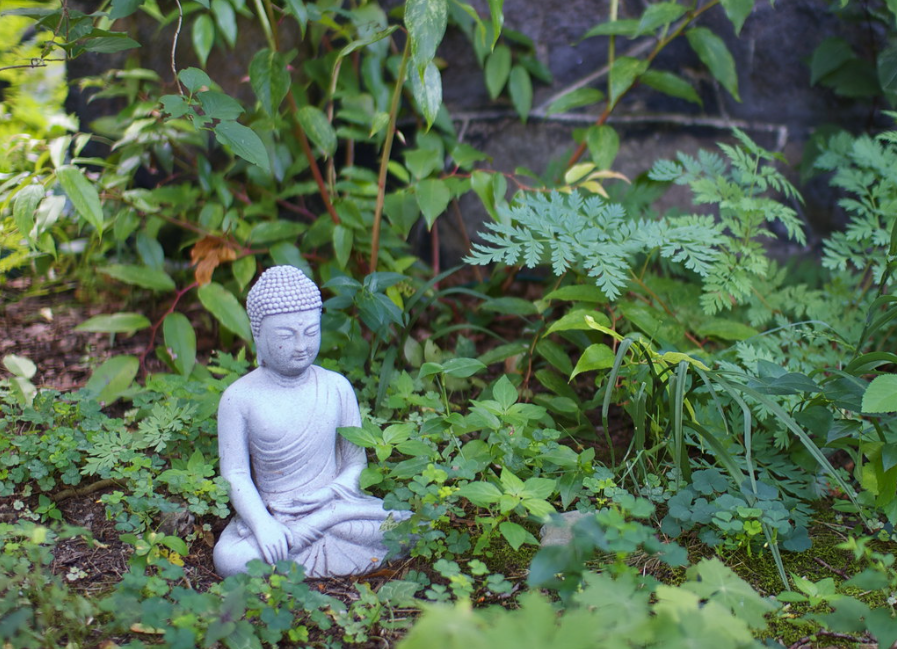
Standing Buddha
The Standing Buddha represents Buddha’s virtues of forbearance and forgiveness. This statue can bring a sense of grace and dignity to your garden, reminding you to stand tall amidst life’s challenges. A Standing Buddha statue can be an impressive centerpiece in your garden, especially if you have a large outdoor space.
Remember, the best Buddha statue for your garden is the one that speaks to you personally and complements your garden’s ambiance. So, take your time, explore the options, and let your intuition guide you to the perfect Buddha statue for your garden.
Other Types of Buddha Statues
Although the statues mentioned above are the most popular ones to have in your garden, there are many others. Here is a breakdown of all the different types of buddha statues…
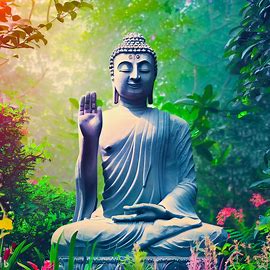 | Protection Buddha “Abhaya Mudra” This Buddha statue is depicted with the right hand raised and facing outwards, symbolizing fearlessness and protection. It’s a powerful symbol of reassurance and blessing. |
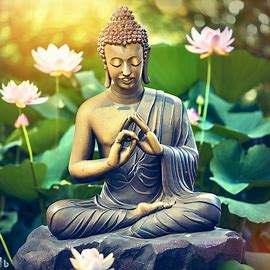 | Teaching Buddha Statue “Dharmachakra Mudra” This statue shows Buddha with hands held up in front of the heart, with thumb and index fingers forming a circle. It represents the teaching phase of Buddha’s life and the wheel of Dharma. |
 | Meditation Buddha “Dhyana Mudra” This Buddha statue is depicted in a seated position with hands resting on the lap, symbolizing meditation and attainment of spiritual perfection. |
 | Earth Touching Buddha “Bhumisparsha Mudra” This statue shows Buddha touching the earth with his right hand, commemorating the moment of Buddha’s enlightenment. |
 | Gift Giving Buddha “Varada Mudra” This Buddha statue is depicted with the left hand facing downward, palm facing outwards, symbolizing the act of giving or generosity. |
 | Debating Buddha “Vikarka Mudra” This statue shows Buddha with one hand raised, thumb and index finger touching, symbolizing intellectual debate and discussion. |
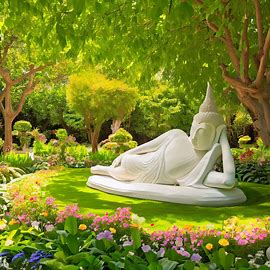 | Reclining Buddha Statue This statue depicts Buddha lying on his right side, representing the historical Buddha during his last illness, about to enter the parinirvana. |
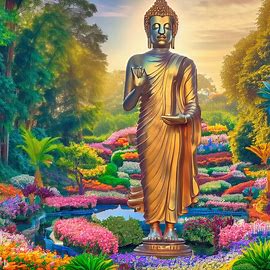 | Standing Buddha Statue “Sukothai” This statue depicts Buddha in a standing position, often with hands in various mudras. It represents grace, dignity, and forbearance. |
 | Laughing Buddha Statue “Buddhai” This jolly figure is often depicted with a large belly, a wide smile, and carrying a sack of treasures. It’s believed to bring wealth, happiness, and prosperity. |
Choosing the Right Buddha Statue for Your Garden
Selecting the right Buddha statue for your garden is a personal journey, one that intertwines your spiritual inclinations with the physical attributes of your garden. Here are some factors to consider and tips to guide you on this path.
Size of the Statue
The size of the Buddha statue should be in harmony with the scale of your garden. A large statue might overpower a small garden, while a tiny one could get lost in a spacious landscape. Consider the viewing distance. A Buddha statue that’s viewed from afar can be larger, while one meant for close-up viewing should be smaller.
Material the Statue is Made From
Buddha statues come in various materials like stone, wood, metal, or ceramic. The choice of material can influence the statue’s durability, maintenance, and overall look. Stone or concrete statues are durable and blend well with natural surroundings, making them a popular choice for gardens.
Design of the Statue
The design of the Buddha statue should resonate with you personally and match the style of your garden. Whether it’s a serene Meditating Buddha for a Zen garden or a cheerful Laughing Buddha for a vibrant flower garden, the design should enhance the garden’s ambiance.
🌿 Mindful Memo: The direction the Buddha statue faces can also have significance. Traditionally, it’s considered auspicious to have the Buddha face the entrance of the home or garden.🌿
Remember, the right Buddha statue for your garden is one that not only complements the physical space but also reflects your spiritual journey. So, take your time, trust your instincts, and you’ll find the perfect Buddha statue that brings peace and serenity to your garden.
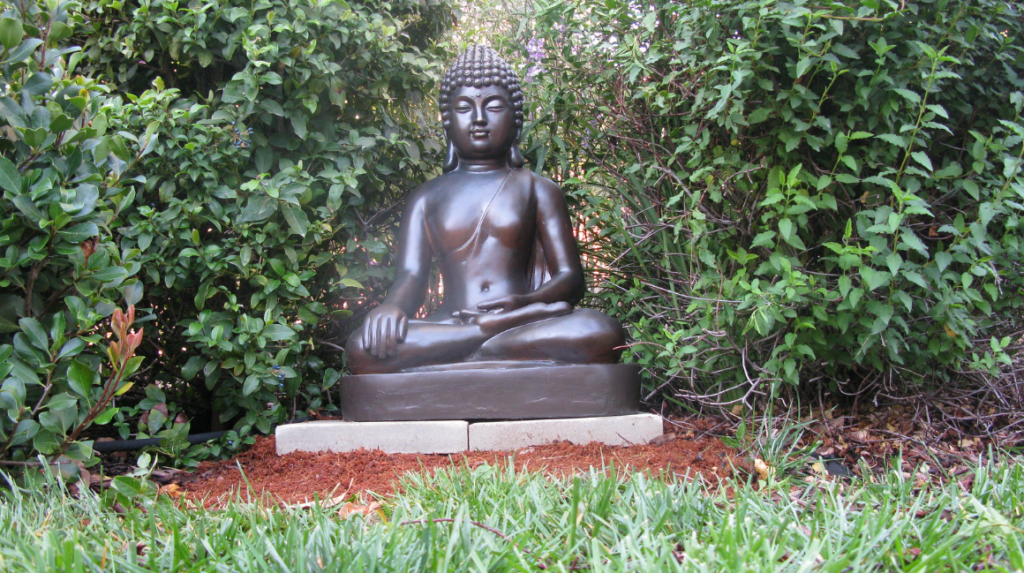
Aesthetic and Spiritual Benefits of Garden Buddha Statues
Adding a Buddha statue to your garden does more than just enhance its visual appeal; it also brings a profound spiritual dimension to your outdoor space. Let’s explore these aesthetic and spiritual benefits further.
Aesthetic Appeal
A well-chosen Buddha statue can be a stunning focal point in your garden, adding a touch of elegance and tranquility. Its timeless beauty can complement various garden styles, from a lush tropical landscape to a minimalist Zen garden.
🌿 Mindful Memo: Use lighting to highlight your Buddha statue at night. This not only enhances its beauty but also creates a magical ambiance in your garden.🌿
Spiritual Benefits
Beyond aesthetics, a Buddha statue can transform your garden into a peaceful sanctuary, a place for reflection and meditation. The presence of Buddha in your garden serves as a constant reminder of the Buddhist principles of peace, compassion, and mindfulness.
Incorporating a Buddha statue in your garden is like inviting peace and serenity into your outdoor space. It’s a journey of creating a garden that nourishes not just the body, but also the soul. So, as you choose your Buddha statue, remember that you’re not just selecting a garden ornament, but a symbol of your inner peace and spiritual journey.
Caring for Your Garden Buddha Statue
Once you’ve chosen the perfect Buddha statue for your garden, it’s important to take good care of it to preserve its beauty and spiritual energy. Here are some tips on maintaining your Buddha statue and ensuring its proper placement for maximum spiritual benefits.
Maintenance
Outdoor Buddha statues can be exposed to various weather conditions, so regular maintenance is crucial. Cleaning your statue gently with a soft brush and mild soapy water can help maintain its appearance. If your statue is made of stone or concrete, consider applying a protective sealant to guard against moisture and frost damage.
Placement
The placement of your Buddha statue can influence the flow of energy in your garden. Traditionally, Buddha statues are placed in a high, clean, and serene spot, facing east towards the rising sun. Avoid placing your Buddha statue on the ground. A raised platform or a spot amidst blooming flowers can be ideal.
Remember, caring for your Buddha statue is part of the journey of creating a peaceful and harmonious garden. It’s a practice of mindfulness and respect, reflecting your commitment to the spiritual path symbolized by the Buddha.
Adding a Buddha statue to your garden is a step towards creating a serene sanctuary, a space for reflection, peace, and spiritual growth.
🌿 Mindful Memo: Remember, the best Buddha statue for your garden is the one that resonates with you and complements you and your garden’s ambiance.🌿
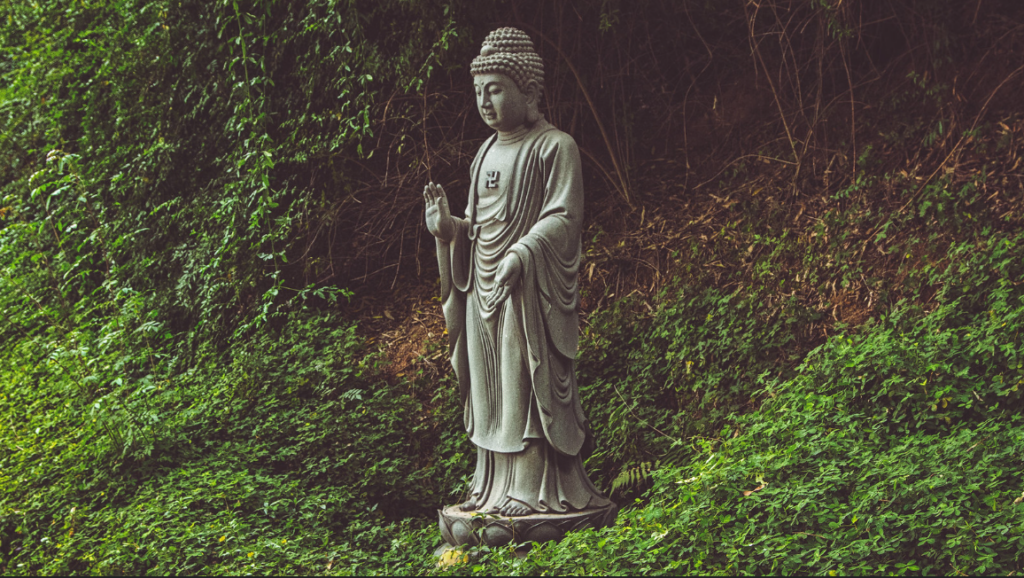
Buddha Statue FAQ – Answers to Common Questions
Q: Can I place my Buddha statue indoors if I don’t have a garden?
A: Absolutely! Buddha statues can be placed indoors, such as in a meditation room or living area. The key is to choose a respectful and clean space.
Q: Is it disrespectful to have a Buddha statue if I’m not a Buddhist?
A: Not at all. While Buddha statues hold religious significance in Buddhism, many non-Buddhists appreciate them for their aesthetic appeal and the sense of peace they bring.
Q: How often should I clean my outdoor Buddha statue?
A: It depends on the material and the weather conditions in your area. If it’s in a shady damp spot, it may collect mold over time. Generally, a gentle cleaning every few months can help maintain its appearance.
Q: Can I paint my Buddha statue to match my garden’s color scheme?
A: While it’s technically possible, it’s important to remember that Buddha statues are religious symbols. Any modifications should be done respectfully and tastefully.
Q: Are there any specific plants or flowers that go well with Buddha statues in a garden?
A: Lotus flowers are often associated with Buddha and Buddhism, but any plant or flower that contributes to a serene and peaceful ambiance would complement a Buddha statue.
Q: What are Mudras?
A: Mudras are hand gestures used in yoga, meditation, and Eastern practices to direct the body’s energy flow. Each mudra carries a specific meaning, representing different states of mind or divine aspects. In Buddha statues, mudras portray teachings or events from his life.
